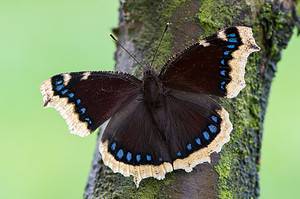If you’re a fan of butterflies, then Arizona is a great place to be! The sunny state is home to an incredible variety of these beautiful and fascinating insects. Whether you’re an avid butterfly watcher or just starting to explore the world of lepidopters, Arizona’s butterflies are sure to captivate and inspire you.
So, let’s discover all the beautiful butterflies that call Arizona home!
1. Monarch (Danaus plexippus)
The monarch butterfly is a distinctive species known for its vibrant orange coloring with black veins and white dots along the wing edges. Caterpillars of the monarch have a plump appearance, with a body featuring white, yellow, and black bands and tentacles at either end.
Arizonians easily recognize the monarch butterfly. In fact, it is often basking in the sun with its wings outstretched to absorb maximum UV radiation.
This butterfly species is among the most extensively studied and widely recognized worldwide, thanks to its fascinating seasonal migration pattern. Every year, millions of monarchs undertake a long journey from the northern United States and Canada to California and Mexico for the winter.
Monarch butterflies require milkweed and flowering plants to thrive in their habitat, regardless of whether they are in a field, roadside area, open space, wetland, or urban garden. While the larvae feed solely on milkweeds, adult monarchs can extract sugars and nutrients by feeding on various nectar-bearing flowers.
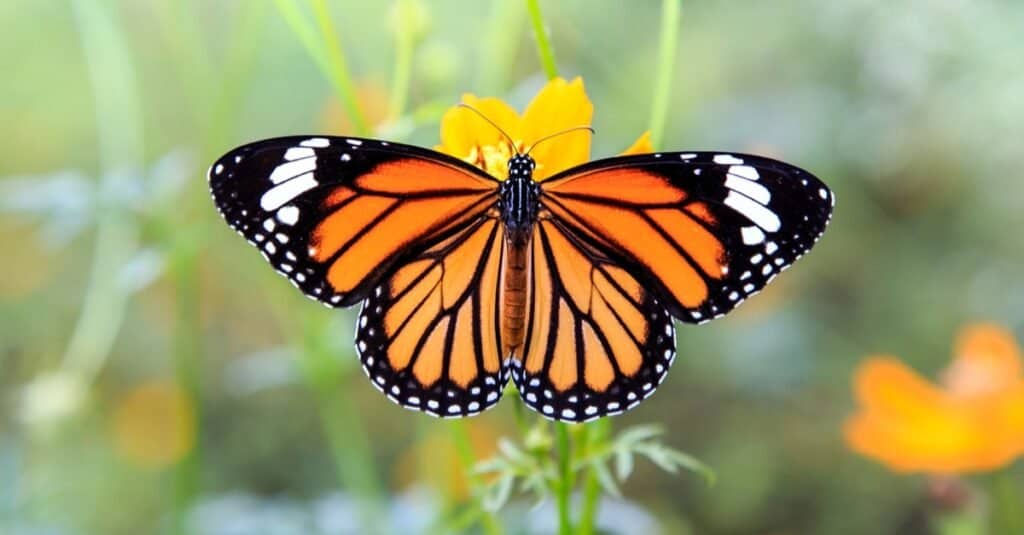
The monarch butterfly is a distinctive species known for its vibrant orange coloring with black veins and white dots along the wing edges.
©CHAINFOTO24/Shutterstock.com
2. Red Admiral (Vanessa atalanta)
The red admiral butterfly is the most common butterfly species in Arizona.
These beautiful butterflies have a wingspan between 1.75 to 2.5 inches. They feature a distinct reddish circular band and white spots on their dark brown wings. The back wings of this species are reminiscent of tree bark. Additionally, their caterpillars have spines that look like hairs and display colors ranging from pinkish-gray to charcoal, with white spots.
Red admirals migrate during winter, heading south towards warmer climates and returning north during late spring. Male red admirals are territorial butterflies that patrol their areas to seek out female mates.
These butterflies can live in various habitats, such as forests, moist woods, marshes, parks, meadows, fields, and even backyards. The caterpillars of this species feed on plants belonging to the Urticaceae family or nettles. Meanwhile, adult Red Admirals primarily feed on tree sap, bird droppings, and rotting fruit. Though, they occasionally feed on the nectar of flowers as well.
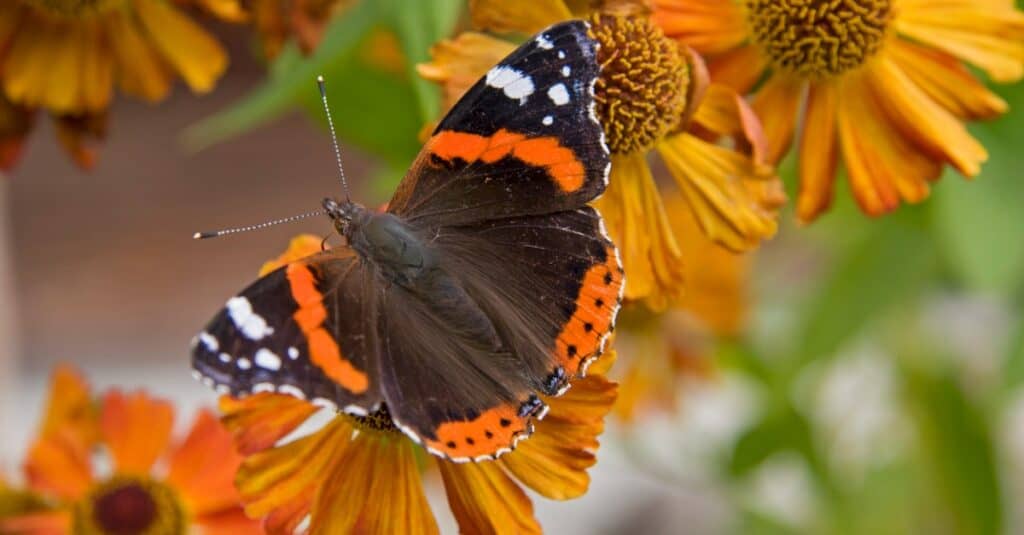
The red admiral butterfly is the most common butterfly species in Arizona.
©iStock.com/Tinieder
3. Red-Spotted Purple (Limenitis arthemis astyanax)
A stunning butterfly commonly seen in the state of Arizona is none other than the red-spotted purple butterfly. With a wingspan that can measure between 3 to 4 inches, this butterfly is an enchanting sight to behold. Its wings feature an iridescent blackish-blue hue and rows of spots along the outer edge, which can vary in color depending on the morph and range from orange and red to light blue. On the underside, the wings are a dark sooty black, adding to the butterfly’s striking appearance.
A noteworthy characteristic of this butterfly is its capacity for intraspecific variation. That means that members of the same species can exhibit strikingly different physical appearances.
These butterflies prefer semi-sunny environments such as streams, edges of forests, woodland paths, and clearings. Unlike other butterfly species, red-spotted purples do not typically feed on flowers. They prefer sap, rotting fruit, animal dung, and carrion.
Interestingly, male red-spotted purple perch on leaves several feet above the ground, where they dart out to inspect potential mates before returning to their chosen spot.
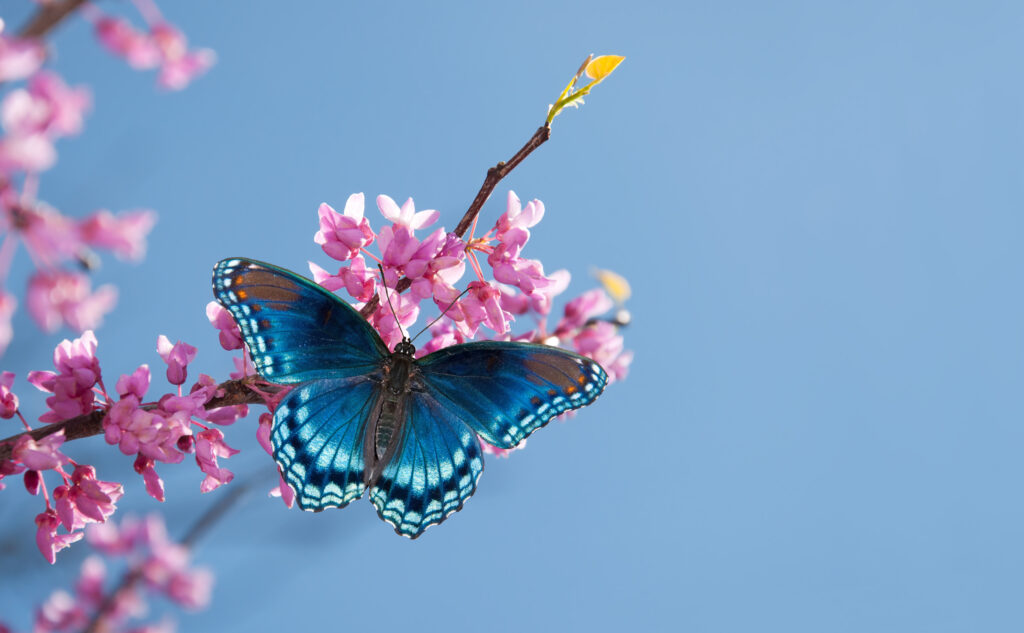
A stunning butterfly commonly seen in the state of Arizona is none other than the red-spotted purple butterfly.
©Sari ONeal/Shutterstock.com
4. Mourning Cloak (Nymphalis Antiopa)
The mourning cloak butterfly stands out with its jet-black wings, which boast a mesmerizing iridescent luster. Adding to its distinctive appearance, the outer wings showcase a vibrant yellow border and a striking row of purple spots. The caterpillar has a black body adorned with white speckles and a row of red spots running down its back.
While the mourning cloak butterfly prefers deciduous forests, it has adapted to developed areas like parks, golf courses, and suburban yards. The mourning cloak is also one of the first butterfly species to become active in spring.
If you come across a mourning cloak butterfly with its wings folded, you might miss it as it’s well-camouflaged.
During winter, most mourning cloaks do not fly south like other butterflies. Instead, they overwinter or spend winter in the same habitat. Adult mourning cloaks shelter in holes in trees or cracks in rocks, shutting down their bodies in a hibernation-like state known as torpor.
The mourning cloak caterpillar feeds in groups on the leaves of deciduous trees. In contrast, the adult butterfly feeds on tree sap, nectar from flowers, and rotting fruit.

The mourning cloak butterfly stands out with its jet-black wings, which boast a mesmerizing iridescent luster.
©Marek Mierzejewski/Shutterstock.com
5. Question Mark (Polygonia interrogationis)
The question mark butterfly is another type of butterfly you can easily spot in Arizona. The wingspan of the question mark butterfly can range from 2.25 to 3 inches. These butterflies are recognized by their striking deep orange hue with black spots and a lavender border. The caterpillars have grey to black tones, with spines located along their sides and cream and orange stripes.
The upper side of the butterflies’ wings displays bright coloring. The lower side appears mottled brown, providing them with effective camouflage as they rest on branches, resembling dead leaves.
These butterflies are named after a slight, light-colored marking on the underside of their wings that looks like a roughly drawn question mark. Males are territorial, chasing away intruders such as flying insects, other butterflies, and sometimes even small birds.
Question mark butterflies are frequently found in swamps, moist woodlands, parks, and residential landscapes. Theyhibernate in warmer climates during winter and emerge on warm, sunny days. These butterflies feed on a variety of food sources, including tree sap, rotting fruit, and carrion, in addition to nectar from flowers.
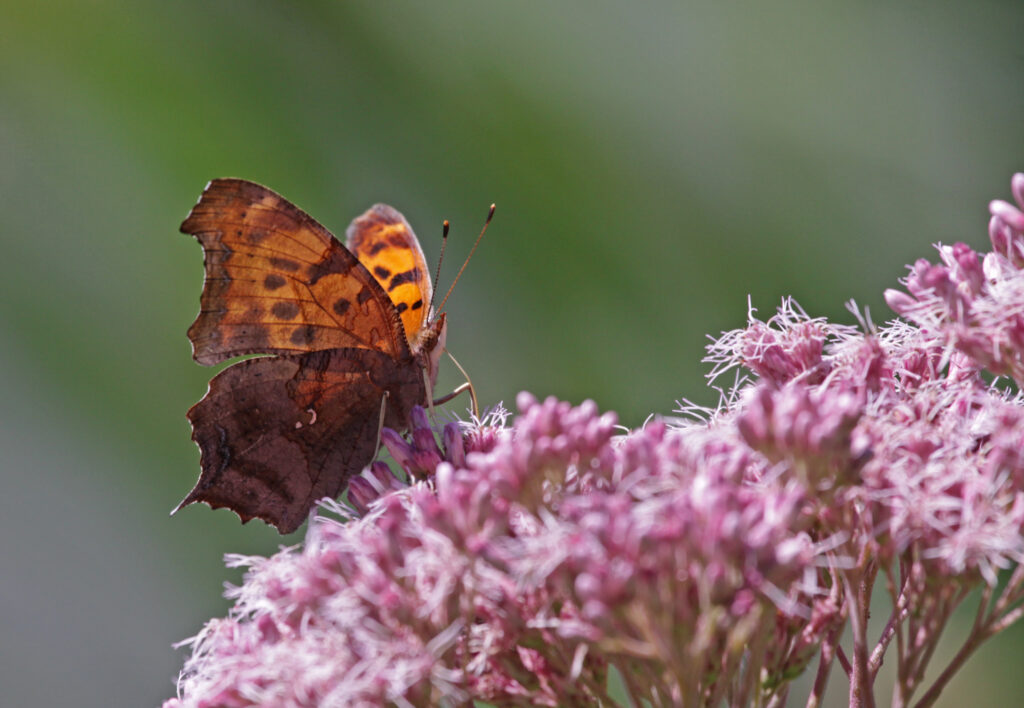
Question Mark butterflies are named after a slight, light-colored marking on the underside of their wings that looks like a roughly drawn question mark.
©Chris Hill/Shutterstock.com
6. Common Buckeye (Junonia coenia)
The common buckeye butterfly boasts a wingspan ranging from 2 to 2.5 inches, exhibiting a mesmerizing blend of brown shades with orange stripes. The butterfly’s wings feature black and white rings that encircle three to four stunning eyespots, vibrant in shades of magenta, blue, green, and orange. Conversely, the caterpillar of this species is adorned with dark brown or black stripes running along its sides and back, while its entire body is filled with spines.
Common buckeyes thrive in open habitats, such as roadsides, old fields, and pastures in Arizona. These butterflies are generally skittish and alert against potential predators but tend to fly low to the ground. They often perch long enough to allow for an opportunity to photograph them.
During the winter season, common buckeyes that inhabit northern states migrate toward the south. Subsequently, they return in the spring for mating. So there are typically more common buckeyes in Arizona during the winter months. The caterpillars of this species prefer to feed on weed plants such as plantain, Gerardia, snapdragon, and toadflax, as well as other native weeds. As for the adult butterflies, they sip nectar from various weedy and ornamental flowers.
In contrast to some butterfly species, which lay eggs on specific leaves, buckeye butterflies lay their eggs on a diverse range of host plants.
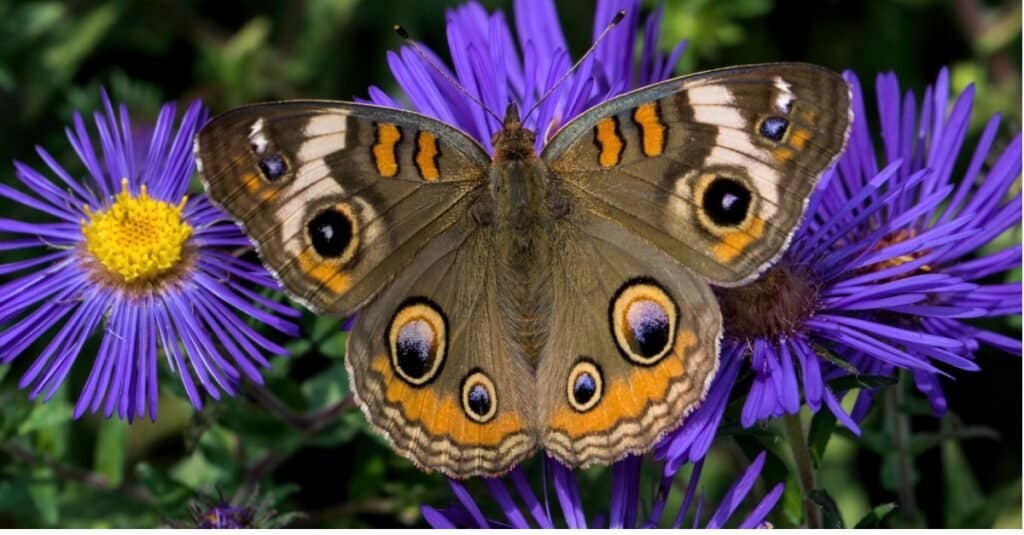
The common buckeye butterfly exhibits a mesmerizing blend of brown shades with orange stripes.
©iStock.com/McKinneMike
7. Common Wood-Nymph (Cercyonis pegala)
The common wood-nymph is another species of butterfly commonly found in Arizona. The common wood-nymph has a wingspan ranging from 2 to 3 inches. Their coloration can differ significantly but generally comprises shades of brown with distinctive dark eyespots. The caterpillars are identifiable by their dark green stripes, white hair, and yellow-green hue
These butterflies are adaptable and can live in various environments, including meadows, open forests, salt marshes, and agricultural fields. Caterpillars typically emerge in the late fall and go into hibernation during the winter season.
Late summer and early fall are the most active periods for the common wood-nymph, and that’s when you’re likely to see them. Although these butterflies occasionally consume flower nectar, they prefer to feed on decomposing fruit or plants.
What’s unique about the common wood-nymph is that it’s one of the few butterfly species whose larvae feed on grass, particularly Kentucky Bluegrass, which is also commonly found on lawns. This means that it’s possible to attract this species without having to plant anything new!
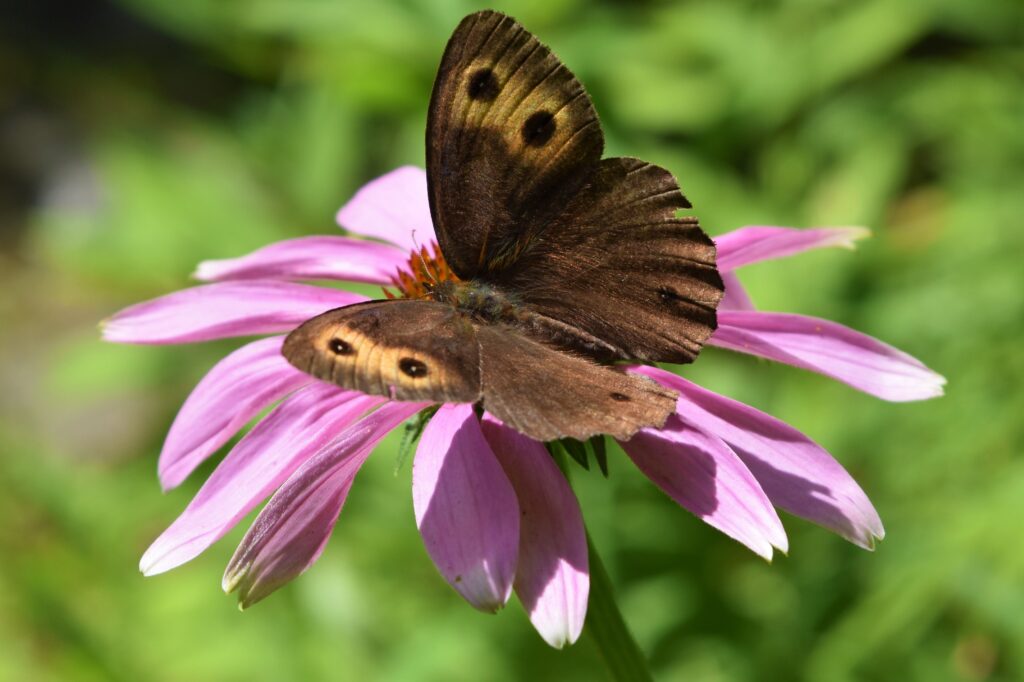
The common wood-nymph is another species of butterfly commonly found in Arizona.
©Kerrie W/Shutterstock.com
8. American Snout (Libytheana carinenta)
The American snout butterfly is a unique species with a wingspan ranging from 1.5 to 2 inches. Its appearance consists of brown coloring adorned with patches of orange and white, which closely resemble a brown leaf. Interestingly, the upper side of the wings appears to be more heavily patterned and darker in color than the lower side.
Although the American snout butterfly migrates north every year, it is rare to see the species as it is often concealed by its excellent camouflage. On the rare occasion they are spotted, it is usually in large migratory groups so vast that they can even darken the sky!
These butterflies live in various habitats, including woodlands, woodland edges, and suburban yards. In some cases, the species forms colonies on hackberry trees, with the adults resting on the leaves and visiting nearby flowers.
The American snout butterfly’s caterpillars feed on various types of hackberries, such as the hackberry, dwarf hackberry, and sugarberry. The adults of this species visit a range of flowers and drink from mud puddles and moist soils near lake shores and creek beds.
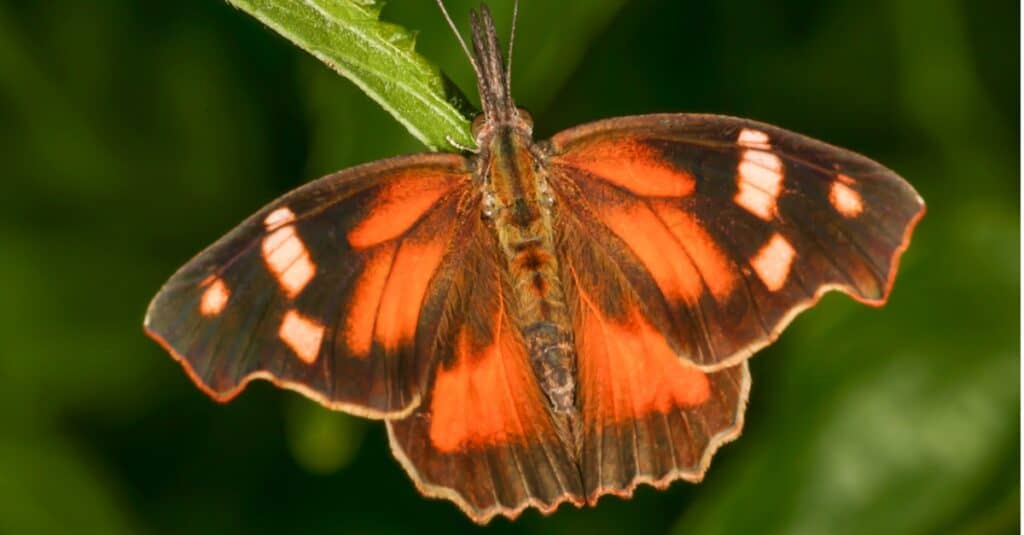
The American snout butterfly’s appearance consists of brown coloring adorned with patches of orange and white, which closely resemble a brown leaf.
©iStock.com/EdwardSnow
9. Azure (Celastrina ladon)
In Arizona, Azure butterflies are a common and widely-seen species found in forest edges, open woodlands, hiking trails, and roadsides.
Azure butterflies have a wingspan that can range from 0.75 to 1.25 inches. They exhibit a coloration that varies from dusky gray to cornflower blue, with spots and stripes in different shades of gray. Males of this species are usually more vibrant in color, and females tend to have a darker hue.
Despite their small size, azures are a true harbinger of spring. They are the earliest native butterfly to emerge from overwintering pupae. It’s not uncommon to spot them even before spring flowers bloom, making them a welcome sight after a long winter. Azures belong to the Gossamer-Winged butterfly family, named for their wings’ fringed, fabric-like texture.
Azure butterflies have a varied diet and will nectar on a wide range of flowers. However, they seem to especially enjoy privet, dogbane, blackberry, common milkweed, and New Jersey tea.
If you are interested in attracting these beautiful butterflies to your garden, we recommend planting a combination of host and nectar plants.
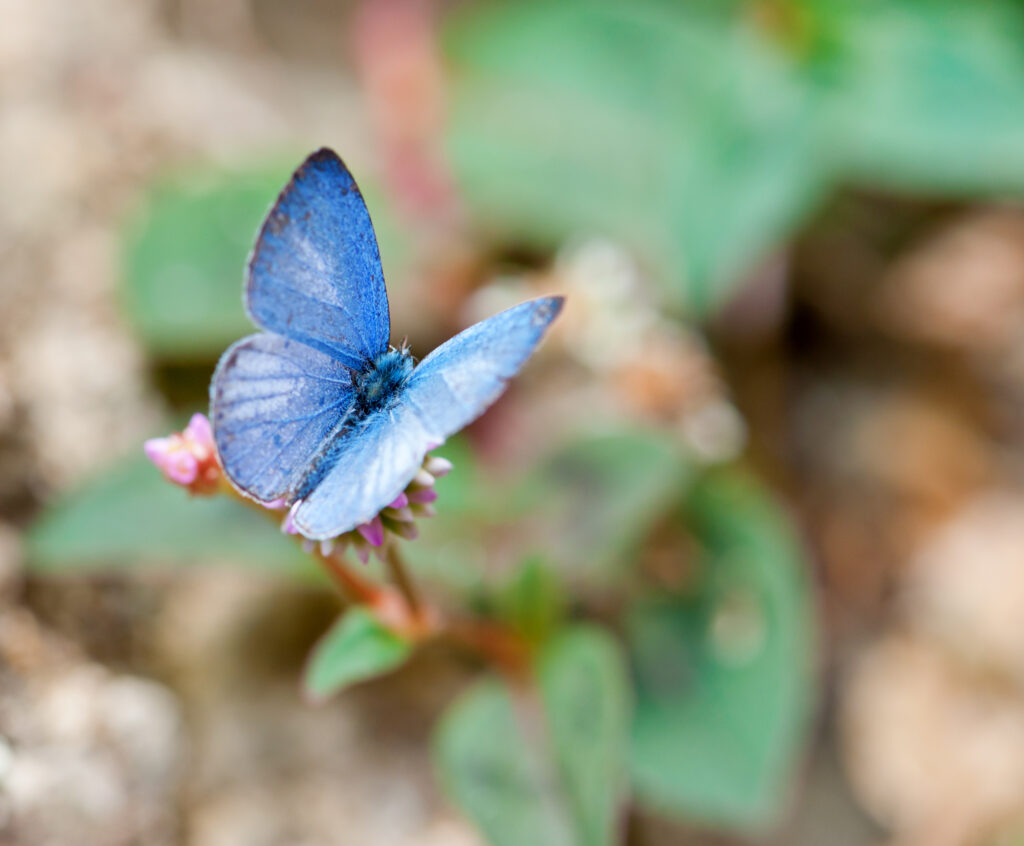
In Arizona, Azure butterflies are a common and widely-seen species found in forest edges, open woodlands, hiking trails, and roadsides.
©johannviloria/Shutterstock.com
10. Gray Hairstreak (Strymon melinus)
The gray hairstreak butterfly has a wingspan of 1 to 1.5 inches and is a diminutive species. Its primary coloring is a slate gray shade, with a solitary, vivid orange spot on each of its lower wings. On the underside of its wings, there is a light gray hue, as well as a stripe pattern in black and white.
If you’re interested in spotting gray hairstreaks, try looking for them in open areas such as roadsides, rural meadows, and unused pastures. Their caterpillars feed on a variety of plants, so you can spot them across many different habitats.
One of the distinguishing features of the gray hairstreak is its thin, long wing tails that resemble hairs. This is a characteristic shared by only a few butterfly species found in Arizona.
They have the broadest range of host plants of any North American butterfly, with caterpillars feeding on flowers and fruits from over 20 different plant families. However, they seem to favor plants in the pea or bean family as well as the mallow family. As they mature, caterpillars may also consume leaves. Adult gray hairstreaks have a varied diet, feeding on everything from nectar to overripe fruits.

One of the distinguishing features of the gray hairstreak is its thin, long wing tails that resemble hairs.
©LorraineHudgins/Shutterstock.com
The photo featured at the top of this post is © Kate Besler/Shutterstock.com
Thank you for reading! Have some feedback for us? Contact the AZ Animals editorial team.





